WashingtonUS lawmakers are traveling to South Korea and Japan to investigate how the US may use their shipbuilding capabilities and experience to strengthen its own capabilities, which are far less than China’s.
Sens. Andy Kim, D-N.J., and Tammy Duckworth, D-Ill., who will arrive in Seoul on Sunday before visiting Japan, intend to meet with leading shipbuilders from the second and third-largest shipbuilding nations in the world. In order to build and maintain noncombatant ships for the U.S. Navy in the Indo-Pacific and attract investments to American shipyards, the senators wish to investigate the potential for joint ventures.
Suggested Videos
Duckworth told The Associated Press, “We already have less capacity now than we did during Operation Iraqi Freedom” in 2003. The capacity must be restored. At the same time, our existing capacity is deteriorating and aging, making repairs more time-consuming and costly.
They are traveling at a time when President Donald Trump is calling for a strategy to engage international partners and revitalize American shipyards. In its yearly budget, the Pentagon is requesting $47 billion for shipbuilding. The urgency comes from the fact that Washington is far behind China in the construction of navy vessels, which worries politicians who fear that China, currently the world’s top shipbuilder, may overtake them in the maritime balance of power.
Duckworth, a member of the Senate Armed Services Committee, expressed her hope that the trip will result in partnerships between the U.S. military, American businesses, and international partners to construct small boats for the Army and auxiliary vessels for the Navy.
Repairing American ships in the Indo-Pacific area is an additional option.
“It doesn’t help the situation if we have to bring ships all the way back to the United States… to wait two years to be fixed,” Duckworth added.
“Auxiliary vessels, which are noncombatant ships like fueling and cargo vessels that support naval and military operations, will be the focus of the discussions,” she said. She stated that the Navy’s auxiliary fleet is too small and old.
According to a report by the Center for Strategic and International Studies, China produced 53% of the world’s commercial shipbuilding capacity in 2024, with South Korea and Japan following closely behind. The United States accounted for 0.1% of this total. Many of the Navy’s key shipbuilding initiatives were one to three years behind schedule, according to a review conducted in April 2024.
The senators are anticipated to meet with officials of the area’s largest shipbuilders while on the trip.
The United States and South Korea are already working together on shipbuilding. Hanwha Ocean finished repairs on a 41,000-ton dry cargo and ammunition ship for the U.S. Navy in South Korea in March. In July 2024, the Korean company acquired a repair arrangement with the U.S. Navy, and its first project was the restoration of USNS Wally Schirra.
The Philadelphia-based Philly Shipyard, which constructs big merchant seamen for the reserve auxiliary fleet, was purchased by Hanwha Group last year.
As part of its trade negotiations with the White House earlier this month, South Korea offered to invest $150 billion in the U.S. shipbuilding sector to back Trump’s Make American Shipbuilding Great Again campaign.
According to Duckworth, she had previously discussed with Hyundai Heavy Industries the possibility of their investing in American shipyards located in the United States.
China merged two state-owned shipbuilders last month to create the largest shipbuilding enterprise in the world. The merged company, China State Shipbuilding Corporation, manufactures everything from nuclear submarines to aircraft carriers for the Chinese navy. It controls 21.5% of the world market for shipbuilding.









